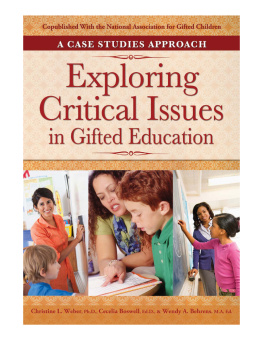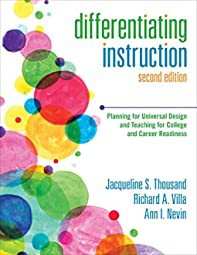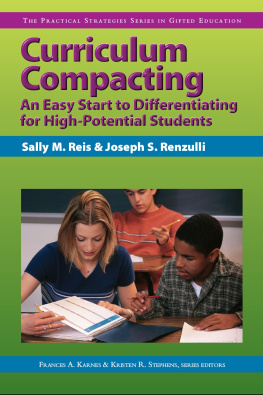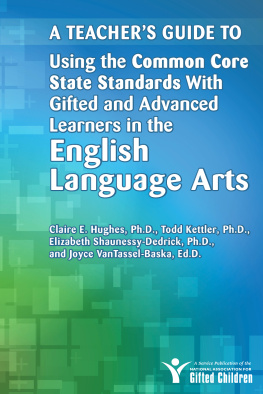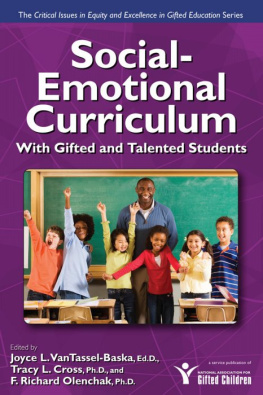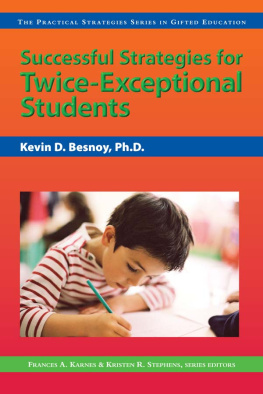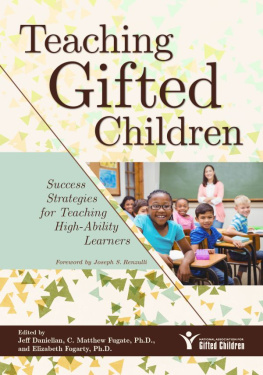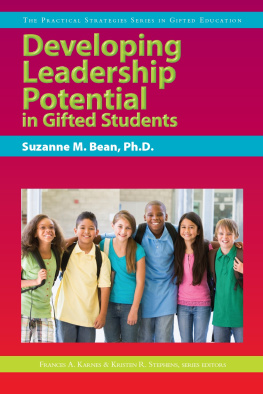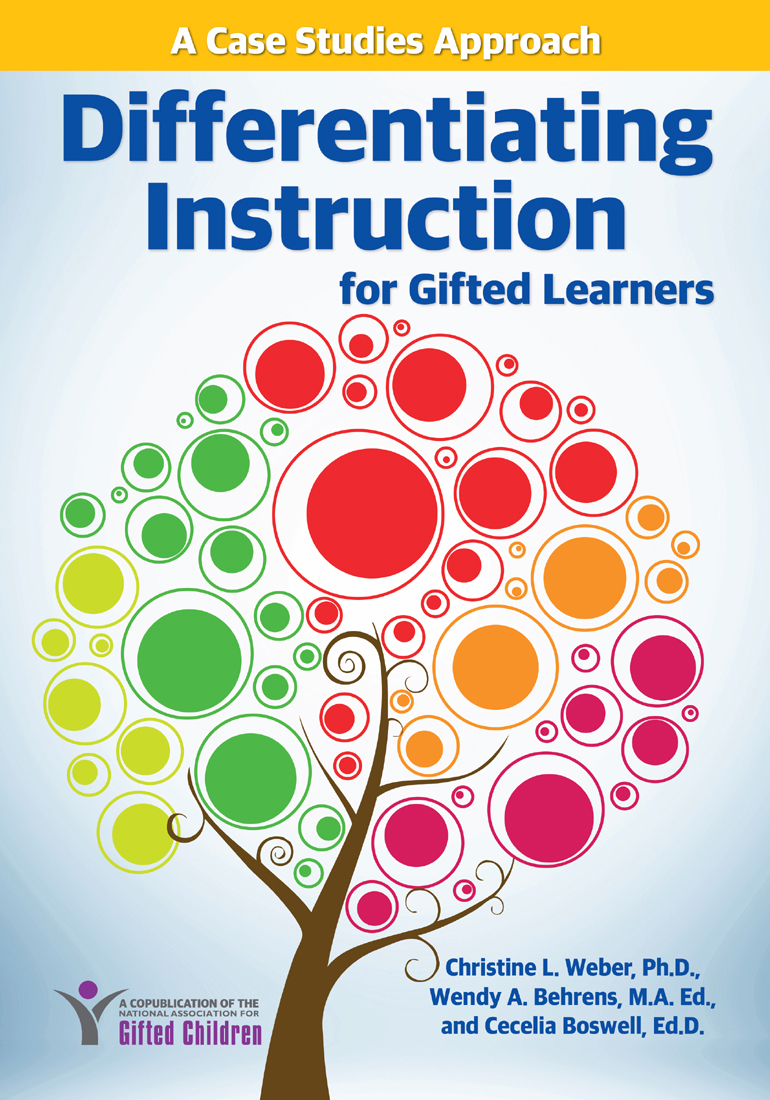
Differentiating
Instruction
for Gifted Learners
A Case Studies Approach
Differentiating
Instruction
for Gifted Learners
Christine L. Weber, Ph.D.,
Wendy A. Behrens, M.A. Ed.,
and Cecelia Boswell, Ed.D.


Library of Congress Cataloging-in-Publication Data
Names: Weber, Christine L. | Behrens, Wendy A. | Boswell, Cecelia.
Title: Differentiating instruction for gifted learners : a case studies
approach / by Christine L. Weber, Ph.D., Wendy A. Behrens, M.A. Ed., and
Cecelia Boswell, Ed.D.
Description: Waco, Texas : Prufrock Press, Inc., [2016] | Includes
bibliographical references.
Identifiers: LCCN 2015044132| ISBN 9781618215314 (pbk.) | ISBN 9781618215338 (epub)
Subjects: LCSH: Gifted children--Education--Case studies. | Individualized
instruction. | Mixed ability grouping in education.
Classification: LCC LC3993 .W369 2016 | DDC 371.95--dc23
LC record available at http://lccn.loc.gov/2015044132
Copyright 2016, Prufrock Press Inc.
Edited by Katy McDowall
Cover and layout design by Raquel Trevino
ISBN-13: 978-1-61821-533-8
No part of this book may be reproduced, translated, stored in a retrieval system, or transmitted, in any form or by any means, electronic, mechanical, photocopying, microfilming, recording, or otherwise, without written permission from the publisher. The purchase of this book entitles the buyer to reproduce student activity pages for single classroom use only.
At the time of this books publication, all facts and figures cited are the most current available. All telephone numbers, addresses, and website URLs are accurate and active. All publications, organizations, websites, and other resources exist as described in the book, and all have been verified. The authors and Prufrock Press Inc. make no warranty or guarantee concerning the information and materials given out by organizations or content found at websites, and we are not responsible for any changes that occur after this books publication. If you find an error, please contact Prufrock Press Inc.

| Prufrock Press Inc.
P.O. Box 8813
Waco, TX 76714-8813
Phone: (800) 998-2208
Fax: (800) 240-0333
http://www.prufrock.com |
Table of Contents
Acknowledgments
The authors wish to express their appreciation to all of the administrators, teachers, counselors, parents, and students whose experiences have served as a basis for case studies in this book. Additionally, the preservice and in-service teachers who willingly agreed to share lesson and unit plans as tools for learning deserve special recognition. Gratitude is also extended to Dr. Cheryll M. Adams for providing her thoughtful reflections and to Amanda Laukitis for once again extending a tireless commitment to edit and offer valuable feedback on content. We are sincerely grateful for the contributions of everyone associated with our work.
Foreword
I t gives me great pleasure to introduce you, the reader, to the second book of case studies by these authors. I have worked closely in several capacities in gifted education with both Christine Weber and Cecelia Boswell, and they are wonderful contributors to the field through service on gifted boards, as national and international consultants, and as authors. All three authors have the needs of gifted learners and those who teach them at the center of their practice as professionals. They provide insight into many issues and problems facing gifted students as well as educators of the gifted and other school personnel who interact with them. They are astute in their selection of problems and issues and present each with professionalism and heightened awareness of the impact of decisions on all involved. As evidenced by the success of the first book of case studies, Exploring Critical Issues in Gifted Education: A Case Studies Approach, our field is in need of cases that draw on specific issues and problems that educators, administrators, consultants, parents, and other school personnel face when dealing with the various ways that giftedness may manifest itself in specific children. If there are still those who see the gifted population as homogeneous, the cases in this book will certainly dispel that myth.
One of the strengths of this book is the attention the authors have given to standards. The NAGC-CEC Teacher Preparation Standards in Gifted and Talented Education (2013b), the NAGC-CEC Advanced Standards in Gifted Education Teacher Preparation (2013a), and the NAGC Pre-KGrade 12 Gifted Programming Standards (NAGC, 2010) have been used as the foundation for the issues presented in the cases. There is a close alignment of each case to one or more of these standards, and a good understanding of these standards will assist with the decision making needed to find possible solutions. Moreover, the Common Core State Standards and the Next Generation Science Standards are used in cases that focus on math, science, or English language arts. This emphasis on standards ensures that the cases as well as the possible solutions are grounded in theory and research, with a focus on student outcomes.
During my career in education, I have served as a classroom math and science educator, gifted coordinator, principal of a school for gifted students, director of a university center for gifted studies, and as a member of the university graduate faculty teaching courses in gifted education. Reflecting through the lens of each of those positions as I read the cases in this book, I found myself pulled toward specific cases that would benefit me in each situation. For example, Miss Parker is in a situation that many educators experience on a daily basis. Thinking back to my early days as a new educator, I would have gained some important insights into how to handle a range of student learning needs if I had had an opportunity to work through this case. Having begun teaching in the era of tracking, the assumption was that the students in each track were homogeneous in learning needs.
Using my gifted coordinator lens, I found a number of cases from which to choose that would lend themselves to engaging educators in professional learning communities. One of my favorites was Miss Wendell, a teacher who is trying to differentiate for a diverse group of learners. Throughout both of the Miss Wendell lessons are various opportunities for discussions on topics such as English language learners in the classroom, differentiating based on students readiness levels, provisions for differentiated lessons that are respectful of students time and attention, and how to develop tiered lessons that offer challenge at each level.
As a principal, I tried to challenge my faculty to broaden their knowledge about gifted learners and the models and strategies that are considered best practices in the field of gifted education. Using this lens, I was particularly drawn to those cases that seemed to challenge long-held beliefs based on myths about giftedness and gifted services. These include a teacher at the Confucius Academy, Mandarin Language Immersion School, who wanted to use the gifted students as teachers helpers for struggling students, and Meredith, whose acceleration request is denied. I would also want to use Differentiating and Assessing Products With Menus and Mr. Randall and Natalie, a case based on using learning contracts. My school was a high school for gifted juniors and seniors, and as with most secondary teachers, the instructors were trained as content specialists. Many did not have many strategies in their toolkit, and I would have used these cases to analyze how to use the strategies effectively.
Next page

